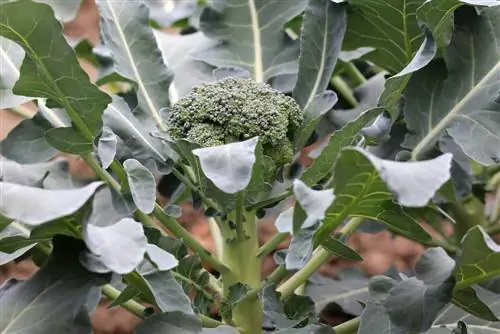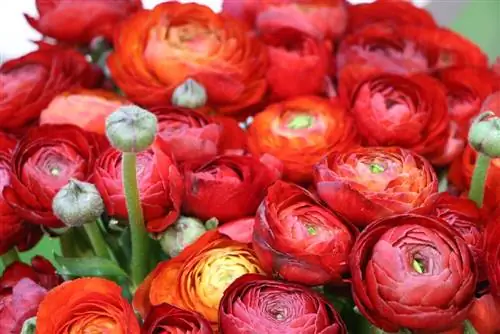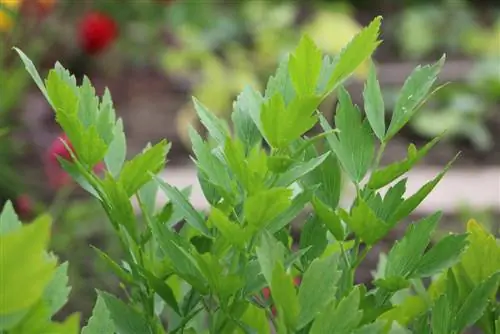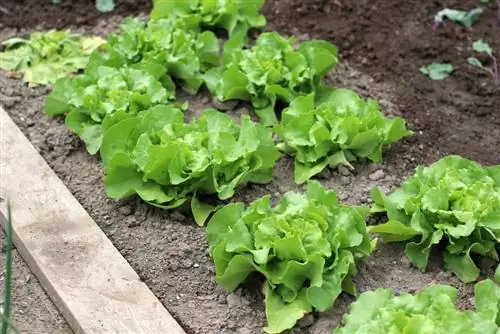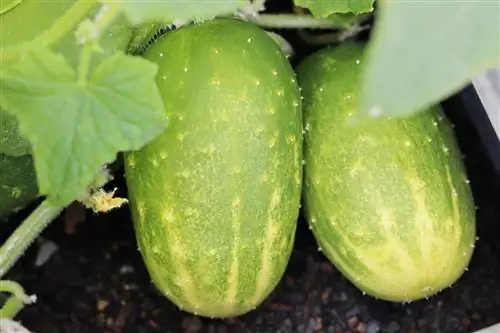- Author admin [email protected].
- Public 2023-12-17 03:39.
- Last modified 2025-06-01 06:48.
Broccoli not only tastes good, it is also he althy. If you have the opportunity to plant one of these in your own garden or on your balcony, you should consider it. Because fresh broccoli, also known as a sprout plant, is a real treat when fresh. As with any plant, there are a few things to keep in mind when growing. Consequently, tips on care, breeding, harvesting, etc. are presented so that every beginner gardener can fulfill their own dream of broccoli.
The ideal location
First of all, the optimal soil should be determined. Broccoli grows best in loamy soil and also needs a lot of sun. In general, you could also plant cauliflower in cool areas on poor soil. The former tends to prefer vegetables. The chances of producing a delicious plant are generally greater in a sunny location. It is important that the broccoli is planted in a place protected from the wind. This can be secured with wooden sticks so that the plant does not break and become damaged.
The ideal time to sow
A distinction is made here as to whether these are early varieties or late varieties. The early ones are planted in advance in a flower pot, preferably on the windowsill in March. From May, as soon as the seedlings are large enough, they are moved outdoors. If these are the late plants, they can be put directly into the ground in April. This requires a little care in advance. In the best case scenario, the sowing bed is leveled and filled with compost. Then loosen it up properly with a rake and start sowing. The individual plants need a distance of around 15 cm from each other in order to thrive optimally.
Let broccoli overwinter properly
The vegetables generally like it warm, but they can still overwinter outside without any problems. It is important that the plants are protected by a wooden frame. If it's quite cold, additional wooden strips should cover the whole thing. Place a fleece or tarpaulin on top of this. The magic is done. In spring the effort is also minimal. Remove the tarp and simply leave the broccoli standing. If you want to plant it, grab the plant by the roots and put it in a bed prepared with compost.
Caring for broccoli
Initially, the plants should only be watered with a gentle shower. The plants are initially around 5 cm tall. Between May and June they grow to a height of 10 cm and have around five leaves. As soon as this is the case, the plants are moved to another location. Attention, as broccoli grows even larger, each one needs a distance of around 60 cm. Winter varieties can also be sown in early summer. Here the individual plants are only transplanted in late summer/autumn. It is important to note whether the broccoli plants sit well in the soil. To find out, all you need to do is gently pull on the top leaves. Then water daily and remove weeds.
Watering - regularity counts
Broccoli usually requires a lot of water and care. Starting with the young plants and ending with the harvest. If you follow the following tips, you can soon look forward to delicious vegetables.
- Water regularly
- Moisture can be increased with a layer of mulch
- Do not water directly over the leaves
- The soil should be evenly wet, avoid waterlogging.
The broccoli harvest: now there is delicious food
Hard to believe but true. Gardeners can expect around one kilo of broccoli per plant. So many vegetables are not only a great sense of achievement, they are also he althy and nutritious. Important: The buds should still be closed but ripe when harvested. The harvest time is usually late summer into autumn. Ultimately, it depends on how the climate develops. Due to global warming, a lot will change in this regard. That's why gardeners should keep a close eye on their plants to see how they develop. First, make sure that the main shoot is about 15 cm long. If this is the case, it will be cut off. If the cut is made directly on the armpit, additional sprouts will sprout on the side.
Fighting pests and diseases
Broccoli is he althy, but unfortunately it is susceptible to some diseases. One of them is slime mold diseases. To prevent this, the soil should be loosened. Lime in the soil can also prevent this. If you want to protect yourself against the so-called cabbage fly, use a plastic or cardboard collar that is wrapped directly around the neck of the plant. Infected broccoli must be removed in any case as it infects the surrounding plants. To generally avoid this, the plants should be planted at larger intervals.
Perennial broccoli makes work easier
Broccoli should never be missing. Since it never goes out of style and still tastes good years later, gardeners can place a “standing order”. No, the vegetables are not delivered, they grow out of the ground year after year. The perennial broccoli only needs to be planted once and ensures a fresh harvest every year. If you eat this vegetable regularly and don't want to do a lot of work, this is ideal. The care remains the same, only protection against snow and frost should be installed in winter. As with normal broccoli, frame the bed with wood and cover it with wooden slats. This guarantees that the broccoli will not miss out in a harsh winter. Because the next harvest is coming, definitely and then it's time again - meal, there's broccoli.
Location and soil
Broccoli, unlike cauliflower, thrives in poor soil and in a cool climate. However, it prefers fertile, loamy soil and a sunny location. If possible, you should look for a place that is well protected from the wind. Otherwise, to be on the safe side, the plants should be secured with wooden or bamboo stakes, as they are easily knocked over in strong winds. The ideal conditions for broccoli are alkaline, nutrient-rich, loose soil.
Sowing and Planting
In March, early varieties are grown in a seed tray on the windowsill and from May onwards the seedlings are planted outdoors. Direct sowing outdoors is possible with the late varieties from the end of April. If possible, the seedbed leveled with the hoe is covered with sifted and well-rotted garden compost, which is carefully tamped down and then loosened with a rake. Sowing takes place between the end of April and mid-June in seed grooves 15mm deep apart. The bed should be watered regularly with the fine spray from the pot. Finally, the young plants are separated to 5cm. Between mid-May and the end of July, when they are about 10cm high and have four to five leaves, they are planted 60cm apart in their final location. To extend the harvest time, special winter varieties can be sown a second time in early summer and planted in late summer. You can check whether the young plants are firmly planted in the soil enough by gently pulling on the upper leaves. Until the plants get used to the new environment, they should be watered daily. The growth of wild herbs should be prevented.
Harvest
Ten plants produce up to 10kg of vegetables. Broccoli is ready to cut when the small flower heads are well developed but the buds are still closed. Depending on the crop, the main harvest period ranges from summer to autumn. First, the main shoot is harvested as soon as it is 10-15cm long. If you cut it off immediately above the armpit, the plant will sprout more side shoots.
Pests and diseases
To protect against the cabbage fly, a cardboard or plastic collar is placed around the root neck. To prevent clubroot, a slime mold disease, the soil is loosened and lime is added. Infected broccoli must be pulled out and destroyed. Yellow spots on the leaves are a sign of downy mildew, which can be avoided by planting widely apart and watering carefully without wetting the leaves.
Popular varieties
- Amigo - solid, grey-blue flowers; well suited for early cultivation;
- Atlantic - green heads with good aroma, medium early and high yielding; rich harvest from late summer to early autumn;
- Marathon - medium late, high-yielding variety; very firm, blue-green flower
Tip:
If you don't want to sow and plant new seeds every year, but would still like to bring these fine vegetables to the table, perennial broccoli is a convenient alternative.

